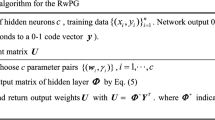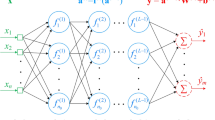Abstract
Multilayer perceptrons (MLPs) and radial basis functions networks (RBFNs) have been widely concerned in recent years. In this paper, based on k-plane clustering (kPC) algorithm, we propose a novel artificial network model termed as Plane-Gaussian network to enlarge the arsenal of the neural networks. This network adopts a so-called Plane-Gaussian activation function (PGF) in hidden neurons. Replacing traditional central point of Gaussian radial basis function (RBF) with central hyperplane, PGF forms a band-shaped rather than spheral-shaped receptive field in RBF, which makes PGF able to express its peculiar geometrical characteristics: locality and globality. Importantly, it is also proved that PGF network (PGFN) having one hidden layer is capable of universal approximation. As a universal approximator, PGFN gives an informal way of bridging the gap between MLP and RBFN. The experiments report comparison between training time and classification accuracies on some artificial and UCI datasets and conclude that (1) PGFN runs significantly faster than MLP and (2) PGFN has comparable or better classification performance than MLP and RBFN, especially in subspace-distributed datasets.








Similar content being viewed by others
Notes
To distinguish with the foresaid parameter k such as kPC and k-means, here let k 1 denotes the number of nearest neighbors to a given sample.
References
Haykin S (1999) Neural networks: a comprehensive foundation, 2nd edn. Prentice Hall, NJ
Bishop CM (1995) Neural networks and pattern recognition. Oxford University Press, Oxford
Barreto AMS, Barbosa HJC, Ebecken NFF (2006) GOLS-Genetic orthogonal least squares algorithm for training RBF networks. Neurocomputing 69(16–18):2041–2064
Sarimveis H, Doganis P, Alexandridis A (2006) A classification technique based on radial basis function neural networks. Adv Eng Softw 37(4):218–221
Smyrnakis MG, Evans DJ (2007) Classifying Ischemic events using a Bayesian inference multilayer percetron and input variable evaluation using automatic relevance determination. Comput Cardiol 34:305–308
Cybenko G (1989) Approximation by superpositions of a sigmoidal function. Math Control Signals Syst 5(4):303–314
Funahashi K (1989) On the approximate realization of continuous mappings by neural networks. Neural Netw 2(3):183–192
Hornik K, Stinchcombe M, White H (1990) Universal approximation of an unknown mapping and its derivatives using multilayer feedforward networks. Neural Networks 3(5):551–560
Park J, Sandberg IW (1991) Universal approximation using radial-basis-function networks. Neural Comput 3(2):246–257
Nam MD, Thanh TC (2003) Approximation of function and its derivatives using radial basis function networks. Appl Math Modell 27(3):197–220
Lehtokangas M, Saarinen J (1998) Centroid based multilayer perceptron networks. Neural Process Lett 7:101–106
Irigoyen E, Pinzolas M (in press) Numerical bounds to assure initial local stability of NARX multilayer perceptrons and radial basis functions. Neurocomputing
Oliveira ALI, Melo BJM, Meira SRL (2005) Improving constructive training of RBF networks through selective pruning and model selection. Neurocomputing 64:537–541
Delogu R, Fanni A, Montisci A (2008) Geometrical synthesis of MLP neural networks. Neurocomputing 71(4–6):919–930
De Silva CR, Ranganath S, De Silva LC (2008) Cloud basis function neural network: a modified RBF network architecture for holistic facial expression recognition. Pattern Recogn 41(4):1241–1253
Qu N, Wang L, Zhu M et al (2008) Radial basis function networks combined with genetic algorithm applied to nondestructive determination of compound erythromycin ethylsuccinate powder. Chemom Intell Lab Syst 90(2):145–152
Huan HX, Hien DTT, Huynh HT (2007) A novel efficient two-phase algorithm for training interpolation radial basis function networks. Signal Process 87(11):2708–2717
Yeung DS, Chan PPK, Ng WWY (2009) Radial basis function network learning using localized generalization error bound. Inf Sci 179:3199–3217
Yeung DS, Wang D, Ng WWY, Tsang ECC, Wang X (2007) Structured large margin machines: sensitive to data distributions. Mach Learn 68(2):171–200
Duda RO, Hart RE, Stock DG (2001) Pattern classification, 2nd edn. Wiley, New York
Bezdek JC (1981) Pattern recognition with fuzzy objective function algorithms. Plenum Press, New York
Bradley PS, Mangasarian OL (2000) k-plane clustering. J Global Optim 16(1):23–32
Castillo PA, Merelo JJ, Arenas MG, Romero G (2007) Comparing evolutionary hybrid systems for design and optimization of multilayer perceptron structure along training parameters. Inf Sci 177(14):2884–2905
Gao D, Ji Y (2005) Classification methodologies of multilayer perceptrons with sigmoid activation functions. Pattern Recognit 38(10):1469–1482
Kiernan L, Mason JD, Warwick K (1996) Robust initialization of Gaussian radial basis function networks using partitioned k-means clustering. Electron Lett 32(7): 671–673
Bruzzone L, Prieto DF (1999) A technique for the selection of kernel-function parameters in RBF neural networks for classification of remote-sensing images. IEEE Trans Vol Geosci Remote Sensing 37(2):1179–1184
Jeffreys H, Jeffreys BS (1988) Methods of mathematical physics, 3rd edn. Cambridge University Press, Cambridge
Chen TP, Chen H (1995) Approximation capability to functions of several variables nonlinear functionals and operators by radial basis function neural networks. IEEE Trans Neural Netw 6(4):904–910
Rudin W (1987) Real and complex analysis, 3rd edn. McGraw-Hill, Inc., New York
Blake C, Keogh E, Merz CJ (1998) UCI repository of machine learning databases [http://www.ics.uci.edu/~mlearn/MLRepository.html]. Department of Information and Computer Science, University of California, Irvine
Draghici S (2002) On the capabilities of neural networks using limited precision weights. Neural Netw 15:395–414
Mirchandani G, Cao W (1989) On hidden nodes for neural Nets. IEEE Trans Circuits Syst 36(5):661–664
Huang GB, Babri HA (1998) Upper bounds on the number of hidden neurons in feedforward networks with arbitrary bounded nonlinear activation functions. IEEE Trans Neural Netw 9(1):224–229
Teoh EJ, Xiang C, Tan KC (2006) Estimating the number of hidden neurons in a feedforward network using the singular value decomposition. LNCS 3971. Springer, Berlin, pp 858–865
Trenn S (2008) Multilayer perceptrons: approximation order and necessary number o hidden units. IEEE Trans Neural Netw 19(5):836–844
Mehrabi S, Maghsoudloo M, Arabalibeik H et al (2009) Application of multilayer perceptron and radial basis function neural networks in differentiation between chronic obstructive pulmonary and congestive heart failure diseases. Expert Syst Appl 36:6956–6959
Bartlett PL (1998) The sample complexity of pattern classification with neural networks: the size of the weights is more important than the size of the network. IEEE Trans Inf Theory 44(2):525–536
Bishop CM, Nabney I (2004) Netlab neural network software. Neural computing research group, Information engineering, Aston University
Moody TJ, Darken CJ (1988) Learning with localized receptive fields. In: Hinton G, Sejnowski T, and Touretzsky D (eds) Proceedings of the 1988 connectionist models summer school. Morgan Kaufmann, pp 133–143
Bellman RE, Roth RS (1969) Curve fitting by segmented straight lines. Am Stat Assoc J 64:1079–1084
Acknowledgments
We thank the anonymous reviewers for their valuable comments and suggestions. We are grateful to the Neural Computing Research Group of Aston university for allowing us to freely use Netlab software. This research was supported by Natural Science Foundation of China (60773061, 60903130), the Jiangsu Science Foundation BK2009393, and Science Foundation of Nanjing Forestry University 163070053 and 163070657.
Author information
Authors and Affiliations
Corresponding author
Rights and permissions
About this article
Cite this article
Yang, X., Chen, S. & Chen, B. Plane-Gaussian artificial neural network. Neural Comput & Applic 21, 305–317 (2012). https://doi.org/10.1007/s00521-011-0546-1
Received:
Accepted:
Published:
Issue Date:
DOI: https://doi.org/10.1007/s00521-011-0546-1




